You're using an outdated browser. Please upgrade to a modern browser for the best experience.
Please note this is a comparison between Version 1 by Hyun Kyu Shin and Version 2 by Conner Chen.
The most practical way of storing hydrogen gas for fuel cell vehicles is to use a composite overwrapped pressure vessel. Depending on the driving distance range and power requirement of the vehicles, there can be various operational pressure and volume capacity of the tanks, ranging from passenger vehicles to heavy-duty trucks. The current commercial hydrogen storage method for vehicles involves storing compressed hydrogen gas in high-pressure tanks at pressures of 700 bar for passenger vehicles and 350 bar to 700 bar for heavy-duty trucks. In particular, hydrogen is stored in rapidly refillable onboard tanks, meeting the driving range needs of heavy-duty applications, such as regional and line-haul trucking.
- hydrogen energy
- hydrogen storage tank
- carbon fiber
1. Hydrogen Storage Systems
Hydrogen storage systems can be classified into physical storage (compressed gas, cryogenic) and storage in solid materials (physisorption, chemical storage [1][2][3][22,23,24]). The gravimetric and volumetric energy densities of hydrogen are used to assess the suitability of the storage media [4][5][25,26].
Figure 1 compares the volumetric and gravimetric H2 densities of the most common hydrogen storage methods. Although solid-state storage systems have a lower volumetric density and theoretical potential, additional system requirements must be met [6][27].

Figure 1.
(
a
) Density for various H
Hydrogen storage is a key component of hydrogen energy systems, particularly in scenarios involving large-scale hydrogen utilization. In the context of the hydrogen economy, hydrogen storage applications can be divided into two groups [9][30]: stationary and mobile applications, as summarized in Figure 2.
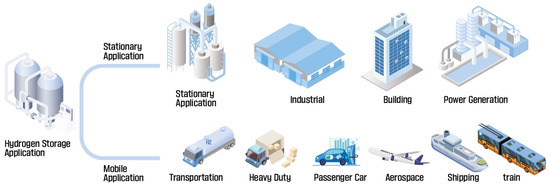
Figure 2. Types of hydrogen storage applications. Stationary includes on-site storage at the point of production or use and stationary power generation. Mobile applications include vehicle fuel and hydrogen transportation.
Various hydrogen storage methods have been compared based on density, pressure, temperature, and cost [4][10][25,31], as summarized in Table 1. Among the various methods, the onboard hydrogen storage method used in passenger cars such as the Mirai, NEXO, and Clarity is a compressed gas method, with hydrogen storage tanks of 350–700 bar. Whiston et al. [11][32] predicted that compressed hydrogen storage methods will be predominantly used by 2035 and will account for 67% of all hydrogen storage methods, and the proportion will rise to 56% by 2050. Cerri et al. [12][33] predicted the cost of storing 1 kg of hydrogen in a tank using the compressed gas method to be USD400–700, as shown in Table 1.
Table 1.
Comparison of the main hydrogen storage media.
| Storage Technologies | Volumetric Density (kg H2/m3) | Gravimetric Density (Reversible) (wt.%) | Operating Pressure (bar) | Operating Temperature (K) | Cost * (USD/kg H2) |
|---|
34,37] calculated the required onboard hydrogen storage tank capacity for each class, as shown in Table 2.
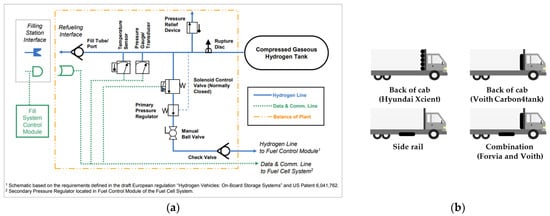
2. Types of Hydrogen Storage Tanks
Hydrogen storage tanks were previously one of four types [8][18][19][29,40,41]; recently, Type V [20][21][22][23][24][42,43,44,45,46], which is a linerless fully composite tank, was developed by Composite Technology Development Inc. [25][26][47,48]. The essential features of each type are as follows:
- Type I: All metal construction;
- Type II: Metal with hoop composite overwrap;
- Type III: Metal liner with full composite overwrap. Composite carries all load;
- Type IV: Polymer liner with a full composite overwrap;
- Type V: Linerless composite vessels.
Type I is an all-metal storage tank. Type II is a tank with a composite material overwrapped around the cylindrical part of the storage tank. In Type II, the internal pressure load is shared between the liner and composite layers. Type III consists of a metal liner fully overwrapped with carbon or glass fiber, whereas Type IV consists of a polymer liner fully overwrapped with carbon or glass fiber. Type V is a linerless structure, with the entire tank made of carbon or glass fiber. Carbon and glass fibers are commonly used as reinforcements in storage tanks, with epoxy or vinyl ester primarily used as the matrix system, as shown in Table 3.
| Type I | Type II | Type III | Type IV | Type V |
|---|
] in North America and Europe.
developed a product with a 700 km driving range by storing 56–112 kg of hydrogen in 4–8 tanks; each hydrogen storage tank had 350 L and 14 kg of hydrogen capacity (7.4%) at 700 bar. Compared with passenger cars carrying 5.6 kg of hydrogen, heavy-duty trucks show an increasing trend of 5.5–20 times in the storage capacity, with a maximum storage of 112 kg, as shown in Table 7. Park, C. et al. [96][114] also reported that buses and trucks use 10–20 times more hydrogen than passenger cars.
Table 7.
Compressed gas hydrogen storage tanks onboard trucks, shown by location.
| HYUNDAI XCIENT 2021 [58][76] | Pressure (bar) | Daimler | HYUNDAI XCIENT Tractor 2023 [97][115] GenH2 [62][80] |
FORVIA XL-Type IV [94][112]Honda Clarity (2016) [44][45][46][14,64,65] |
Mercedes Benz GLC (2017) |
Water Volume (liter)DAF-VDL H2 Share Project (27 t) (2020~) [54][72] |
Voith Carbon4tank [ [47][48][49][66,67,68] |
||||||
|---|---|---|---|---|---|---|---|---|---|---|---|---|---|
| 95 | ] | MAN | (35 t) | [63][81] |
Scania (27 t) (2019~) [64][82] |
||||||||
| Compressed gas (H2) | |||||||||||||
| Application | |||||||||||||
| [ | 113 | ] | |||||||||||
| Schematic | 17–33 | 3–4.8 (system) |
350 and 700 | [32]ambient | [54]400–700 * | ||||||||
 |
 |
 |
 |
 |
|||||||||
| Photos |  |
 |
 |
 |
|||||||||
| Photos |  |
 |
 |
 |
 |
 |
|||||||
| Advanced Structural Technologies, Inc. |  |
||||||||||||
| [66][84] | III | 350–517 | 290–540 | ||||||||||
| Tank Location | Off-road, mining, construction, marine, rail | 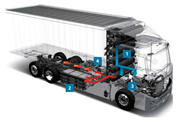 |
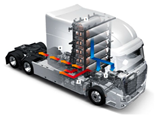 |
||||||||||
| Cryogenic (H2) | 35–40 | 6.5–14 (system) | 1 | 20 | |||||||||
 |
Composition | 200–270 * | |||||||||||
| All Metal | Metal Liner with Composites Layer | Metal Liner with Full composites Overwrapped | Pressure (bar) | Metal Liner with Full composites Overwrapped | Full Composites | 700 | 700 | 700 | 700 | 700 | |||
| Operator | COOP | - | Testing | - | COOP | ||||||||
| Liaoning Alsafe Technology | Akso | ||||||||||||
| [67][85]Cryo-compressed (H2) | 30–42 | 4.7–5.5 (system) | 350 | 20 | |||||||||
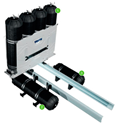 |
III | 350–700 | 3–180 | ||||||||||
| Capacity H2 | Hydrogen, medical, SCUBA, etc. | /No. of Tanks/Pressure | 31 kg/7 tanks/350 bar | 68.6 kg/10 tanks/700 bar | 80 kg/7 tanks/700 bar | Tank price (USD/kg) |
++ 400 |
||||||
| (83) | + | (86) |
Tank volume (liter) | 156.6 (52/52/52) |
140 (36/104)− |
Pressure (bar)(700) | 142.2 (52/25.3/64.9)− |
350(633) | 141.3 (24/117)− |
350 | Liquid | ||
| AMS composites cylinders [68][86 | 350 | 117 | (unknown) | High pressure—solid | 40 | ||||||||
| ] | 350 | 350 | |||||||||||
| III | 300 | 1–10 | Oxygen, UAV | 2 (system) | 80 | 243–298 | |||||||
| Gravimetric capacity | − | - | + | ++ | ++ | Tank capacity (H2 kg) | 6.33 | 5.64 | 5.6 | 5.46 | 4.4 | Sorbents (H2) | |
| Range (km) | 400 | ||||||||||||
| Avanco (Hexagon) | 400 | [69] | 1000 | [400 | 400 | 500 | 20–30 | 5–7 (material) | 80 | ||||
| 87] | 77 | ||||||||||||
| IV | 300–381 | 350 | Distribution, train | Composite layers load sharing | Tank weight (kg) estimation |
111 kg | Tank Capacity (H2 | kg) (37/37/37) |
31 [6045% load bearing104 kg (36/104) |
unknown | ][78unknown | ] | 30unknown |
| 80 | 30 | 31 | |||||||||||
| Cylinders Holding [70][88 | 33 | ||||||||||||
| ] | I | 300 | 166 | Metal hydrides (H) | <150 | Gravity capacity2–6.7 (material) | 1–30 | Ambient-553 | >500 | ||||
| Complex hydrides (H) | <120 | 4.5–6.7 (material) | 1–50 | 423–573 | 300–450 * | ||||||||
| Chemical hydrides (H) | 30 | 3–5 (system) | 1 | 353–473 | 160–270 ** |
* Cost estimates based on 500,000 units of production. ** Regeneration and processing costs not included.
The onboard compressed gas hydrogen system for fuel cell electric vehicles (FCEVs) is depicted in Figure 3 and is categorized into the hydrogen storage tank and the BOP (balance of plant). Passenger car hydrogen storage tanks are designed with 1–3 tanks, considering packing based on 5–6 kg of hydrogen storage capacity depending on the vehicle’s layout. The BOP consists of a fill port, regulator, valves, and sensors. Heavy-duty truck hydrogen storage tanks have higher hydrogen storage capacity than passenger cars and use various mounting methods such as side rail, back of cab, combo, canopy, and top of the body [13][34].
In particular, development and demonstration of operations and initial commercialization are ongoing for heavy-duty trucks (classes seven and eight) [14][35], employing various hydrogen storage tank packing methods, as shown in Figure 3. While most passenger cars are designed with a hydrogen storage tank capacity of at least 5.6 kg per vehicle, heavy-duty trucks have a wide range of types and uses [15][36]. Kast et al. [13][16][
| 80% load bearing |
| 100% load bearing |
| 100% load bearing |
Type I is currently the most widely used vessel, accounting for approximately 90% of the market. However, Type I is more than three times heavier than Type III and Type IV, whereas Type IV costs over 300% more than Type I [33][55]. Type II is over 50% more expensive and 30–40% lighter than Type I. Type III is 50% lighter but costs more than twice as much as Type II, shown in Figure 4. Additionally, Type III and Type VI offer the advantage of hydrogen storage at higher pressures for higher energy storage density.
3. On-Road Application
Current commercially available passenger cars with hydrogen pressure vessels are summarized in Table 4. Some initial models used 350 bar hydrogen pressure vessels, but owing to hydrogen storage limitations, most models currently use 700 bar hydrogen pressure vessels; 1–3 pressure vessels are used depending on the vehicle layout. The hydrogen storage capacity of vehicles equipped with hydrogen pressure vessels ranges from a minimum of 4.4 kg to a maximum of 6.33 kg. Hydrogen storage tanks adopt the Type IV manufacturing method that uses polymer liners (HDPE, PA6, etc.), and the wet winding process is widely used as an essential filament winding method during production.
Table 4.
Hydrogen vehicles and specification of hydrogen storage tanks.
The Tucson ix35, manufactured by Hyundai Motor Company in 2013, was the first commercialized FCEV passenger car, storing 5.64 kg of hydrogen in two hydrogen pressure vessels (36 L/104 L) with a total volume of 140 L. Toyota began developing fuel cell systems in 1992 and started sales on a limited lease basis in 2002 [50][69]. The mass-produced Mirai was launched in 2014, and the 2021 model has a total hydrogen storage capacity of 5.6 kg in three hydrogen pressure vessels (52 L/25.3 L/64.9 L) with a total volume of 142.2 L. In 2016, Honda launched the Clarity, which stores a total of 5.46 kg of hydrogen in two hydrogen tanks with a capacity of 141 L. In 2017, the Mercedes Benz GLC, capable of storing 4.4 kg of hydrogen in a 117 L tank, was launched. The 2018 Hyundai NEXO model stores 6.33 kg of hydrogen in three identical-capacity (52 L) tanks with a total capacity of 156.6 L. As shown in Table 4, original equipment manufacturers (OEMs) efficiently packed hydrogen pressure vessels of the same or different sizes according to the vehicle’s layout, securing adequate hydrogen storage capacity [51][70]. In the transportation sector, hydrogen energy is gaining importance for its application to heavy-duty trucks in Table 5, which have a driving range of more than 805 km, fast fuel supply, and shift operation [11][52][32,71]. According to an IEA report [53][18], as of 2022, 12 manufacturers have manufactured or plan to manufacture 16 types of fuel cell trucks by 2024. According to the Interreg North-West Europe H2-Share report [54][72], 15 types are currently in operation. Hydrogen storage tank suppliers, listed in Table 6, are developing or manufacturing Type III and Type IV hydrogen storage tanks for passenger cars, commercial vehicles, and transport tube trailers, with operating pressures ranging from 350 to 700 bar.
| ] | |||||
| IV | |||||
| 275 | |||||
| 30~53 ft trailer | trailer | ||||
| EKC [72][90] | IV | 245 | 148–324 | Medical, industrial, truck | |
| Faber Industries [73][91] | I, II, III, IV | 200–1100 | SCBA, hydrogen, CNG, food, etc. | ||
| Hexagon Purus [74][92] | IV | 250–950 | 193–1745 | Stationary, distribution, etc. | |
| Hanhwa [75][76][93,94] | IV | 350–700 | 10.8–2078 | Passenger cars, buses, and trucks | |
| IlJin Hysolus [77][95] | IV | 700 | 500 | Transport, mobility | |
| Infinite composites [78][96] | V | 310 | 325 | Spacecraft applications | |
| Luxfer [79][97] | I, II, III | 90–350 | 0.8–2250 | SCBA, specialty, medical. CO2, aerospace | |
| Mahytec [80][98] | IV | 60–500 | 300–850 | Stationary storage | |
| Nproxx [81][99] | III, IV | 100–700 | - | Stationary, railroad, passenger car | |
| Plastic Omnium [82][100] | IV | 200–700 | - | Passenger car, truck | |
| Quantum Fuel systems [83][101] | IV | 350–700 | 26–994 | Passenger car, truck, bus, transportable, aerospace | |
| Steelhead composites [84][102] | III, IV | 200–700 | 90–270 | Storage and transport | |
| Faurecia Ullit [85][103] | IV | 350–700 | 120–691 | ||
| 89 | |||||
| ] | |||||
| [ | |||||
| 90][107,108] | III | 350 | 59–140 | Passenger car, bus, logistic vehicle | |
| 112 kg/6 tanks/700 bar | Heavy truck | ||||
| Toyoda Gosei [86][104] | IV | 700 | 25.3–64.9 (w/o truck) | Passenger vehicle, truck | |
| Voith composites [87][105] | IV | 700 | 350 | Heavy-duty trucks | |
| Wiretough [88][106] | II (wire) | 350–700 | 765–1750 | Ground storage | |
| Jiangsu Guofu Hydrogen Energy Equipment Co., Ltd. [ | Sinoma Science and Technology Co., Ltd. [89][91][92][107,109,110] | III | 350–700 | 28–320 | Bus, UAM |
As shown in Table 4, passenger cars can store 5.4–6.33 kg of hydrogen in hydrogen storage tanks with volumes ranging from 25.3 to 117 L per vehicle and achieve a maximum driving range of 650 km. Class 8 heavy-duty trucks, as shown in Table 5, store 30–31 kg of hydrogen, with a driving range of 400–500 km.
The first heavy-duty FCEV vehicle, the Hyundai Xcient model, underwent test runs for 2 years and has covered 5 million km in Switzerland since October 2020. Full commercial sales of the hydrogen-powered fuel cell truck Xcient began in December 2022 [93][111]. At IAA Transportation 2022, FORVIA [94][112] exhibited a product that could store 80 kg of hydrogen by mounting five 700 bar XL Type IV hydrogen storage tanks in the cab module (diameter: 200–700 mm, length: up to 3300 mm) and two tanks in the module on the side (diameter: 700 mm, length: 2500 mm). Voith [95][113]
